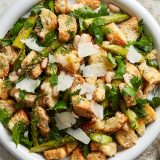Panzanella—that classic Tuscan salad that tosses together hunks of stale bread with juicy tomatoes and a simple dressing—is the epitome of cucina povera: Make a meal from a marriage of leftovers and whatever is seasonally abundant. We found that a useful lesson as we wondered how to enjoy panzanella when tomatoes aren’t at their peak.
Turns out, panzanella is just fine without tomatoes. In fact, the dish predates their arrival in Italy. As early as the Middle Ages, it was known as pan lavato (or “washed bread”), which combined a jumble of vegetables with crusty bread to sop up any juices. Modern panzanella may be synonymous with tomatoes, but more than any one ingredient, at heart it’s a salad based on striking a balance of textures and bright, savory, fresh flavors.
“The perfect panzanella needs sweetness and acidity and the right amount of juice,” writes “Salad Freak” author Jess Damuck. When you approach it this way, you find there’s a panzanella for every season. For example, “Salt, Fat, Acid, Heat” author Samin Nosrat suggests an autumnal version of roasted squash and sage, or a radicchio and Roquefort for winter.
In a nod to springtime, we built our panzanella around asparagus. First, we roast the asparagus drizzled with olive oil, softening the stalks and enhancing their grassy flavors with smoky, caramelized sweetness. To make the dish more substantial, we incorporate white beans, which we heat briefly before tossing with garlic and lemon; the warmed beans better absorb the bright flavors.
And for savory depth, we toast our bread with grated Parmesan, transforming the torn bits into bite-size bursts of roasty, nutty, cheesy flavor. Ample fresh herbs—dill, parsley and mint—lighten the salad, lifting it with the green zing of spring.
There was only one problem: Our star vegetable, the asparagus, lacked the inherent juiciness of a tomato, so our early attempts kept turning out too dry, with nothing for the croutons to sop up. But the solution was as simple as adding an extra splash of liquid to the canned beans to give our panzanella the perfect amount of lush creaminess—no tomatoes needed.
Panzanella Without Tomatoes?
Shaula Clark
May - June 2023

Get the Recipe
Asparagus Panzanella with Parmesan, White Beans and Herbs
A spring remake of the basic bread salad
Photo: Erika LaPresto; Styling: Wes Martin







